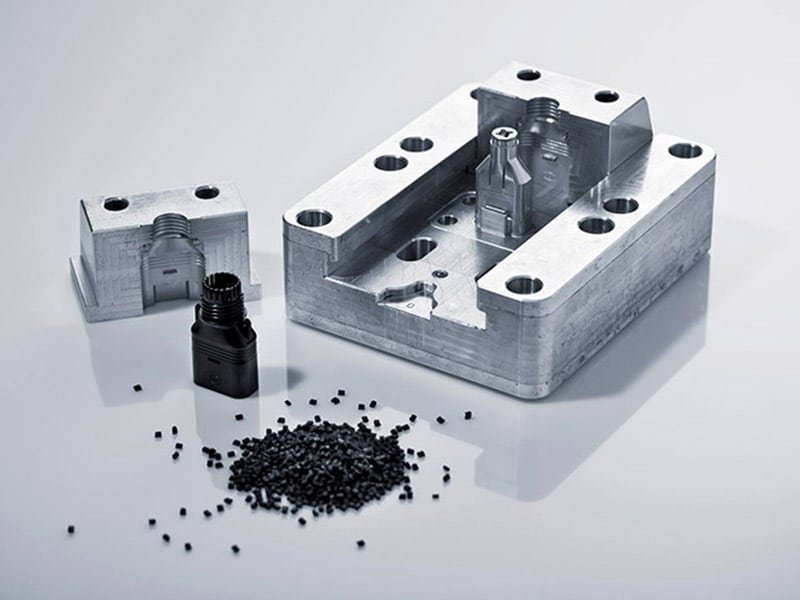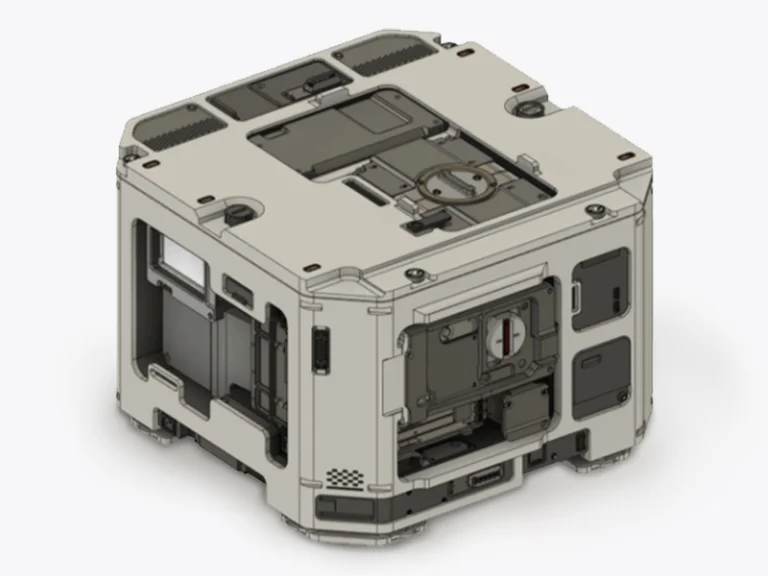Nylon vs ABS, which one is better for injection molding? Among the various materials used in injection molding, Nylon and ABS (Acrylonitrile Butadiene Styrene) are the most popular plastic injection molding materials. In this post, we will compare Nylon and ABS to determine which material is better suited for injection molding applications. By comparing their properties, processing characteristics, and suitability for various applications, we will provide insights to help manufacturers make informed decisions when selecting materials for their projects.
Overview of Nylon
Nylon is a synthetic polymer belonging to the polyamide family, known for its exceptional mechanical properties and versatility. It is produced through the polymerization of amides, resulting in a strong and durable material. There are several types of Nylon, with the most common being Nylon 6 and Nylon 66:
Nylon 6: Created from caprolactam, it offers good flexibility and is easier to process. It is often used in applications requiring moderate strength and toughness.
Nylon 66: Made from hexamethylenediamine and adipic acid, it possesses higher tensile strength and thermal stability compared to Nylon 6, making it suitable for more demanding applications.
Key Nylon Characteristics
Nylon exhibits high tensile strength, making it ideal for applications that require durable components, such as gears, bearings, and automotive parts.
Nylon also has excellent flexibility, allowing it to absorb impact without breaking, which is crucial in applications subjected to dynamic loads.
Nylon is resistant to many chemicals, oils, and solvents, making it suitable for use in harsh environments.
Nylon’s melting point is typically around 220°C (428°F), which allows it to maintain performance in high-heat applications.
Overview of ABS
ABS (Acrylonitrile Butadiene Styrene) is a thermoplastic polymer that combines three distinct components: acrylonitrile, butadiene, and styrene. This combination results in a material that balances strength and toughness with ease of processing. ABS is widely used in various applications due to its favorable properties and cost-effectiveness.
Key ABS Characteristics
ABS is renowned for its excellent impact resistance, making it an ideal choice for products that are prone to rough handling or mechanical stress, such as toys and protective equipment.
ABS is easy to mold and can be processed using standard injection molding techniques. It flows well in the mold, allowing for intricate designs and uniform thickness.
Compared to other engineering plastics, ABS is relatively inexpensive, making it a popular choice for mass-produced consumer goods and components where cost is a critical factor.
Nylon vs ABS Performance Comparison
Both Nylon and ABS offer unique properties that cater to different application needs in the injection molding process. In the following section, we will compare nylon vs ABS in mechanical properties, thermal properties, and chemical resistance.
Mechanical Properties Comparison
Tensile Strength: Nylon has a higher tensile strength compared to ABS, with values ranging from 70-100 MPa for Nylon and 30-45 MPa for ABS. The tensile strength of Nylon is more than double that of ABS, making it an exceptionally robust material.
Impact Resistance: ABS has a much higher impact strength compared to Nylon.
Durability: Nylon’s high tensile strength and impact resistance contribute to its excellent durability. ABS also offers good overall strength and toughness, suitable for various consumer goods and functional parts.
Thermal Properties Comparison
Heat Resistance: Nylon has a higher heat deflection temperature compared to ABS, with some types like Nylon 46 withstanding temperatures up to 150°C for extended periods. After being reinforced with glass fibers, Nylon 66 can withstand thermal deformation temperatures above 250°C. ABS has a lower heat deflection temperature, limiting its use in high-heat environments.
Thermal Stability: Nylon’s high melting point of around 260°C ensures better thermal stability compared to ABS, which has a melting point of 220°C. The thermal deformation temperature of ABS surpasses that of Nylon and PVC, ensuring greater dimensional stability under varying thermal conditions.
Chemical Resistance Comparison
Nylon: Nylon is resistant to corrosion, highly resistant to alkalis and most salt solutions, and can also withstand weak acids, motor oils, gasoline, aromatic hydrocarbons, and general solvents.
ABS: ABS is impervious to water, inorganic salts, bases, and many acids, though soluble in ketones, aldehydes, and chlorinated hydrocarbons. ABS offers good chemical resistance, but Nylon is slightly better in this aspect.
| Property | Nylon | ABS |
|---|---|---|
| Tensile Strength | 70-100 MPa | 30-45 MPa |
| Impact Resistance | Good, but lower than ABS | Excellent, high impact strength |
| Durability | Highly durable, suitable for demanding applications | Good durability, suitable for consumer products |
| Heat Resistance | High heat deflection temperature (up to 150°C for some types) | Lower heat deflection temperature |
| Thermal Stability | Melting point around 260°C | Melting point around 220°C |
| Chemical Resistance | Resistant to alkalis, oils, and weak acids | Resistant to water, bases, and many acids; soluble in ketones and chlorinated hydrocarbons |
Nylon vs ABS Injection Molding Comparison
Different Injection Molding Process Conditions
The processing conditions for Nylon and ABS differ significantly, primarily in terms of temperature and moisture sensitivity:
| Parameter | Nylon | ABS |
|---|---|---|
| Drying Temperature | 80°C (16 hours) | 75-80°C (2-3 hours) |
| Injection Temperature | 230-280°C | 220-250°C |
| Mold Temperature | 80-90°C | 75-85°C |
| Injection Pressure | 60-120 MPa | 75-125 MPa |
| Injection Speed | High speed | Medium speed |
Nylon requires higher processing temperatures and longer drying times due to its hygroscopic nature, meaning it absorbs moisture from the environment. This moisture must be removed before processing to avoid defects in the final product. ABS, being less sensitive to moisture, simplifies the preparation process and is generally processed at lower temperatures, which can reduce energy consumption.
Comparison of Cycle Times and Efficiency
The cycle times for injection molding can vary significantly between Nylon and ABS due to their differing thermal properties and processing requirements:
Nylon: The higher processing temperatures and the need for drying can lead to longer cycle times. Additionally, Nylon’s tendency to shrink as it cools requires careful mold design and cooling strategies, which can further extend production times.
ABS: ABS typically allows for shorter cycle times due to its lower processing temperatures and reduced moisture sensitivity. This efficiency makes ABS a preferred choice for high-volume production runs, especially in consumer goods where cost and speed are critical.
Nylon vs ABS Cost Comparison
When we compare the cost, two factors need to be considered. They are material costs and processing costs.
Material Costs
Nylon is generally more expensive per unit weight compared to ABS. The higher cost of Nylon can be attributed to its complex manufacturing process and the inherent properties that require more advanced techniques for production. For example, Nylon’s strength and durability come at a premium, making it suitable for high-performance applications, but this also results in a higher price point. In contrast, ABS is more affordable and is often chosen for projects where cost is a significant factor. Its lower material cost makes it a popular choice for mass production of consumer goods and functional parts.
Processing Costs
The processing costs associated with each material also differ significantly due to their properties:
Nylon: Requires higher processing temperatures (230-280°C) and longer drying times due to its moisture sensitivity. This necessitates additional equipment and energy consumption, which can increase overall production costs.
The need for drying Nylon before processing adds complexity and time to the manufacturing process, potentially leading to higher labor costs and longer lead times.
ABS: Easier to process with lower injection temperatures (220-250°C) and less sensitivity to moisture. This simplicity allows for faster cycle times and reduced energy costs during production.
ABS’s forgiving nature in processing means it can be molded with less stringent requirements, leading to lower scrap rates and improved production efficiency.
Nylon vs ABS Application Comparison
Best Applications for Nylon
Nylon is a versatile material known for its strength, durability, and resistance to wear and chemicals. Its properties make it suitable for a wide range of applications across various industries:
Automotive Industry: Used in components such as oil reservoirs, radiator tanks, gears, bearings, and various interior and exterior parts due to its high strength and heat resistance.
Electrical Industry: Commonly used for electrical connectors, housings, and insulators because of its excellent electrical insulating properties and resistance to chemicals.
Textiles and Clothing: Widely used in the production of garments, including shirts, raincoats, and lingerie, as well as in industrial applications like ropes and nets due to its flexibility and durability.
Medical Applications: Employed in medical devices such as catheter shafts and balloon tubing, where biocompatibility and strength are critical.
Industrial Applications: Used for manufacturing machine parts, plumbing fittings, and various mechanical components like gears and wear strips due to its toughness and fatigue resistance.
Consumer Products: Found in everyday items such as toothbrushes, fishing lines, and guitar strings, showcasing its versatility and performance in diverse applications.
Best Applications for ABS
ABS is known for its excellent impact resistance, ease of processing, and cost-effectiveness, making it popular in various industries:
Consumer Electronics: Commonly used in the housings of electronic devices, such as computers, televisions, and smartphones, due to its good impact resistance and aesthetic finish.
Toys: Widely used in the production of toys, including LEGO bricks, because of its durability and safety features.
Automotive Components: Utilized in parts such as dashboards, interior trim, and exterior body panels, where impact resistance and dimensional stability are essential.
Household Appliances: Found in appliances like vacuum cleaners and kitchen gadgets, where its strength and ease of molding are advantageous.
Piping and Plumbing: Used in plumbing fittings and pipes due to its resistance to chemicals and ease of installation.
3D Printing: A popular material for 3D printing applications because of its ease of use, lower printing temperatures, and good surface finish, making it ideal for prototypes and functional parts.
Learn more:plastic materials selection and application
Conclusion
Nylon and ABS are widely used materials in injection molding, each with its own advantages and disadvantages. When selecting between Nylon and ABS for injection molding, it is essential to consider the specific requirements of the application, including mechanical properties, processing conditions, and cost constraints. Both Nylon and ABS have their unique advantages and are widely used in injection molding. By understanding the key differences between these materials, manufacturers can make informed decisions and select the most appropriate material for their specific applications.



